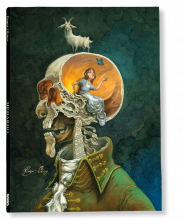Tag: null
Totale: 4024
Noam Weisbrod: Los desafíos mundiales en agua y comida
Noam Weisbrod: Profesor de hidrología en el Departamento de Hidrología Ambiental y Microbiología del Instituto Zuckerberg para la Investigación del Agua, que forma parte de los Institutos Jacob Blaustein para la Investigación del Desierto en la Universidad Ben-Gurion del Negev.
Visita: congresofuturo.cl
- Visualizzazioni: 920
- Lingua:
 | Sottotitoli:
| Sottotitoli:  | Licenza: © all rights reserved
| Licenza: © all rights reserved
- Fonte: Congreso Futuro | Durata: 19.57 min | Pubblicato il: 26-10-2020
-

- Categoria: Congreso futuro 2018 - Toma Conciencia
- Scarica: MP3 | MP4 | alta risoluzione
- Condividi Commenta
A voi la parola - Puntata #1
Abbiamo provato un nuovo formato, nel quale gli utenti possono intervenire direttamente e parlare di un argomento che gli sta a cuore. Diteci cosa ne pensate. In questa puntata: Marco: per una moneta locale - Giuseppe: guida scuolabus - Francesco: la Spagna peggio dell'Italia - Luca: fibromialgia, questa sconosciuta.
Visita: contro.tv
- Visualizzazioni: 920
- Lingua:
 | Licenza: © all rights reserved
| Licenza: © all rights reserved
- Fonte: Luogo Comune | Durata: 50.18 min | Pubblicato il: 02-09-2020
-

- Categoria: Contro Tv
- Scarica: MP3 | MP4 | alta risoluzione
- Condividi Commenta
Paolo Flores d'Arcais - Questione di vita e di morte. L'eutanasia come diritto umano, contro la tortura
Festa Scienza Filosofia, 12 aprile 2019 ore 21:30
Auditorium San Domenico
La Corte Costituzionale ha imposto al Parlamento di legiferare entro il prossimo settembre sulla questione del fine vita, ritenendo che l'attuale legislazione sia in conflitto con le norme fondamentali del nostro ordinamento. A chi appartiene infatti la vita? Chi può decidere se essa si è trasformata in tortura? Perché su di essa dovrebbe decidere un estraneo, un'autorità religiosa, una maggioranza parlamentare, e non tu stesso, che quella vita vivi? La legittimità del suicidio assistito ... continua
Auditorium San Domenico
La Corte Costituzionale ha imposto al Parlamento di legiferare entro il prossimo settembre sulla questione del fine vita, ritenendo che l'attuale legislazione sia in conflitto con le norme fondamentali del nostro ordinamento. A chi appartiene infatti la vita? Chi può decidere se essa si è trasformata in tortura? Perché su di essa dovrebbe decidere un estraneo, un'autorità religiosa, una maggioranza parlamentare, e non tu stesso, che quella vita vivi? La legittimità del suicidio assistito ... continua
Visita: www.festascienzafilosofia.it
- Visualizzazioni: 920
- Lingua:
 | Licenza:
| Licenza:

- Fonte: Festa Scienza Filosofia | Durata: 83.92 min | Pubblicato il: 2019-04-23
-

- Categoria: Festa di Scienza e Filosofia 2019
- Scarica: MP3 | MP4 | alta risoluzione
- Condividi Commenta
Night Fright
A rocket crashes and a mutant monster is on the loose! It's John Agar to the rescue in this low budget chiller
- Visualizzazioni: 920
- Lingua:
 | Licenza: © all rights reserved
| Licenza: © all rights reserved
- Fonte: archive.org | Durata: 75.57 min | Pubblicato il: 2019-02-18
-

- Categoria: archive.org
- Scarica: MP3 | MP4 | alta risoluzione
- Condividi Commenta
The Cabinet of Dr. Caligari
The Cabinet of Dr. Caligari () is a 1920 German silent film horror film, directed by Robert Wiene and written by Hans Janowitz and Carl Mayer. Considered the quintessential work of German Expressionism cinema, it tells the story of an insane hypnotist (Werner Krauss) who uses a Sleepwalking (Conrad Veidt) to commit murders. The film features a dark and twisted visual style, with sharp-pointed forms, oblique and curving lines, structures and landscapes that lean and twist in unusual angles, and shadows and streaks of light painted directly onto the sets
- Visualizzazioni: 920
- Lingua:
 | Licenza: © all rights reserved
| Licenza: © all rights reserved
- Fonte: Public Domain | Durata: 51.02 min | Pubblicato il: 2019-02-11
-

- Categoria: archive.org
- Scarica: MP3 | MP4 |
- Condividi Commenta
La Gran Historia - Aumento de la resistencia a los antibióticos
Los expertos llevan años alertando de que la resistencia bacteriana a los antibióticos está aumentando. Tanto que para la Organización Mundial de la Salud (OMS) ya es un problema de salud pública a nivel mundial.
Esta resistencia se debe al mal uso y abuso de los antibióticos por parte de la población y también en animales destinados a consumo humano.
En este episodio hablamos de cómo se ha llegado a esta situación en México y de las posibles consecuencias de vivir en un mundo sin antibióticos.
- Visualizzazioni: 919
- Lingua:
 | Licenza: © all rights reserved
| Licenza: © all rights reserved
- Fonte: Hispan Tv | Durata: 25.5 min | Pubblicato il: 2019-07-04
-

- Categoria: Hispan Tv
- Scarica: MP3 | MP4 | alta risoluzione
- Condividi Commenta
Woody Woodpecker Season04 Episode08 - The Mouse and the Lion
Woody Woodpecker is a fictional animated character anthropomorphic woodpecker who appeared in theatrical short films produced by the Walter Lantz Studio and distributed by Universal Pictures during the golden age of American animation
- Visualizzazioni: 919
- Lingua:
 | Licenza: © all rights reserved
| Licenza: © all rights reserved
- Fonte: archive.org | Durata: 5.92 min | Pubblicato il: 2019-03-08
-

- Categoria: Woody Woodpecker
- Scarica: MP3 | MP4 | alta risoluzione
- Condividi Commenta
Bodei, Ferraris, Gregory, Reale: Vertigine dell’enciclopedia
Dispositivo d’ordine per eccellenza, il campo enciclopedico ambisce a sistemare il sapere secondo un criterio ontologico che è tuttavia caratterizzato da una struttura paradossale, perché tale criterio viene rovesciato in un criterio alfabetico che restituisce alla consultazione accostamenti fortuiti. Questi sono i temi discussi in questo grande dibattito.
Remo Bodei, Maurizio Ferraris, Tullio Gregory, Giovanni Reale
Vertigine dell’enciclopedia - L'alfabeto come ordine e come caso.
Conduce: Armando Torno
Visita: www.festivalfilosofia.it
- Visualizzazioni: 918
- Lingua:
 | Licenza: © all rights reserved
| Licenza: © all rights reserved
- Fonte: Festivalfilosofia | Durata: 59.98 min | Pubblicato il: 17-11-2020
-

- Categoria: festivalfilosofia 2010 - fortuna
- Scarica: MP3 | MP4 |
- Condividi Commenta
Napoli: la demolizione delle Vele di Scampia
Per gli abitanti di Scampia, nella periferia nord di Napoli, la demolizione degli emblematici e fatiscenti alloggi popolari delle "Vele" è essenziale per risollevarsi da una condizione di marginalità, e scrollarsi di dosso il peso di un'immagine legata al traffico di droga e alla criminalità organizzata. La ricollocazione delle famiglie, soprattutto dei residenti illegali, non è tuttavia semplice.
- Visualizzazioni: 918
- Lingua:
 | Sottotitoli:
| Sottotitoli:  | Licenza: © all rights reserved
| Licenza: © all rights reserved
- Fonte: Vele di Scampia | Durata: 31.75 min | Pubblicato il: 06-11-2020
-

- Categoria: Arte
- Scarica: MP3 | MP4 | alta risoluzione
- Condividi Commenta
La Gran Historia - Uruguay, el país latinoamericano con mayor número de suicidios
El suicidio se ha convertido en la segunda causa de muerte entre los jóvenes de 15 a 29 años en todo el mundo.
Según los datos de la Organización Mundial de la Salud (OMS), cada 40 segundos una persona se quita la vida, unas 800 mil al año.
Las enfermedades mentales son la principal causa, por lo que la depresión es la responsable del 90 por ciento de los suicidios que se llevan a cabo en el mundo.
Una cifra a tener muy en cuenta ya que el diagnóstico de esta enfermedad es uno de los factores más importantes: de cada 100 personas que tienen depresión 80 no ... continua
Según los datos de la Organización Mundial de la Salud (OMS), cada 40 segundos una persona se quita la vida, unas 800 mil al año.
Las enfermedades mentales son la principal causa, por lo que la depresión es la responsable del 90 por ciento de los suicidios que se llevan a cabo en el mundo.
Una cifra a tener muy en cuenta ya que el diagnóstico de esta enfermedad es uno de los factores más importantes: de cada 100 personas que tienen depresión 80 no ... continua
- Visualizzazioni: 918
- Lingua:
 | Licenza: © all rights reserved
| Licenza: © all rights reserved
- Fonte: Hispan Tv | Durata: 25.47 min | Pubblicato il: 2019-07-04
-

- Categoria: Hispan Tv
- Scarica: MP3 | MP4 | alta risoluzione
- Condividi Commenta





























